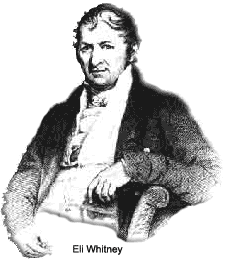Eli Whitney was born in Westboro, Massachusetts, on December 8, 1765. Young Eli showed an interest in mechanics and engineering. While still in his teens, he developed a shop on his father's farm where he produced nails and other small items difficult to obtain during the American Revolution. He entered Yale during his twenties and received his degree in 1792.
 Eli Whitney next went to Georgia in hopes of finding employment as a tutor. During a visit to the Georgia home of Mrs. Nathanael Greene, widow of the Revolutionary War hero, Whitney became acquainted with the dilemma faced by Southern cotton producers. Their crop commanded high prices, but the cost of processing it also was high. Extensive hand labor was required to separate the seed from the fiber; often as many slaves were needed for this task as tending the crop. Cotton production was not, therefore, economically viable in the South.
Eli Whitney next went to Georgia in hopes of finding employment as a tutor. During a visit to the Georgia home of Mrs. Nathanael Greene, widow of the Revolutionary War hero, Whitney became acquainted with the dilemma faced by Southern cotton producers. Their crop commanded high prices, but the cost of processing it also was high. Extensive hand labor was required to separate the seed from the fiber; often as many slaves were needed for this task as tending the crop. Cotton production was not, therefore, economically viable in the South.
In a letter to his father on September 11, 1793, Whitney described the process that led to his most famous invention:
In about ten Days I made a little model, for which I was offered, if I would give up all right and title to it, a Hundred Guineas. I concluded to relinquish my school and turn my attention to perfecting the Machine. I made one before I came away which required the labor of one man to turn it and with which one man will clean ten times as much cotton as he can in any other way before known and also cleanse it much better than in the usual mode. This machine may be turned by water or with a horse, with the greatest ease, and one man and a horse will do more than fifty men with the old machines. It makes the labor fifty times less, without throwing any class of People out of business.Whitney had devised a cotton gin (short for engine), which mechanically separated seed from fiber. This improvement altered the Southern economy by making it profitable to raise and process cotton. Whitney formed a partnership with Phineas Miller, Mrs. Greene’s foreman (and later her husband). A patent was awarded for the machine in 1794, but the concept was simple and easily imitated. As a result, pirated versions of the gin were common and provided him no income. Attempts to enforce his patent rights in court were expensive and unproductive. Disappointed and bitter, Whitney returned to New England in 1798.
During that year, Whitney won a contract from the federal government for the production of 10,000 military muskets. The key to his winning bid was the development of a reliable process for manufacturing interchangeable firing mechanism parts. He called this his "uniformity system." The inspiration came from techniques that Whitney had developed in the manufacture of his cotton gin.
The objective of Whitney's strategy was for machines to produce parts, each of which had a tight enough tolerance that it could be used with other parts to assemble a whole product without manual labor to file and fit. The process was easier to describe than execute, and the government officials in charge of Whitney's contract were obliged to wait until 1809 for the final delivery of the 10,000th musket, despite a stipulation in the contract for delivery in 1800. They correctly understood that this process would be critical to America's need to defend itself.
Some of the aspects of Whitney's "uniformity system" may have existed earlier and he may have been aware of some French processes before devising his own. Nevertheless, he brought many ideas together and advanced the acceptance of his manufacturing concepts. The standardization of interchangeable parts was a major contribution to the development of American industry.
Whitney died at New Haven, Connecticut, on Jan 8, 1825.